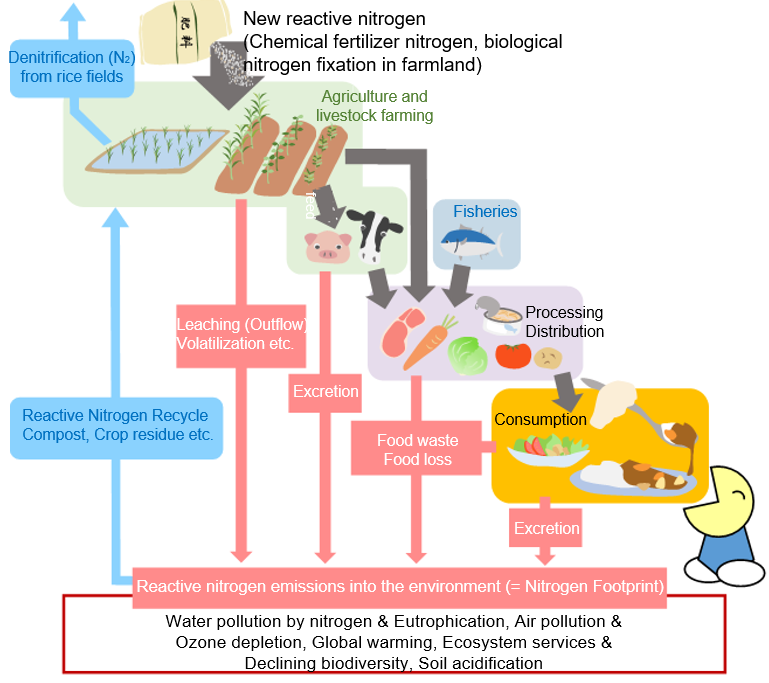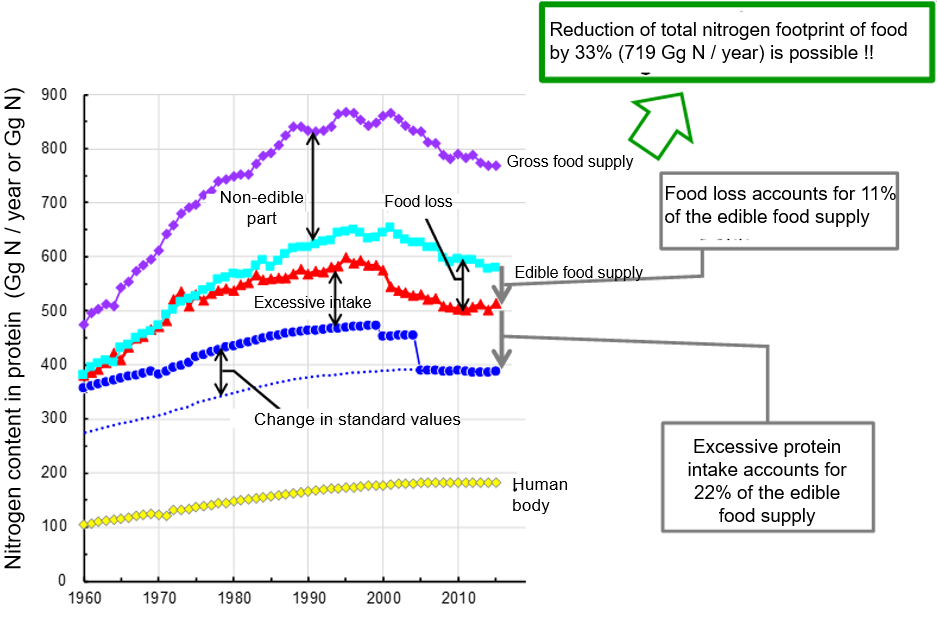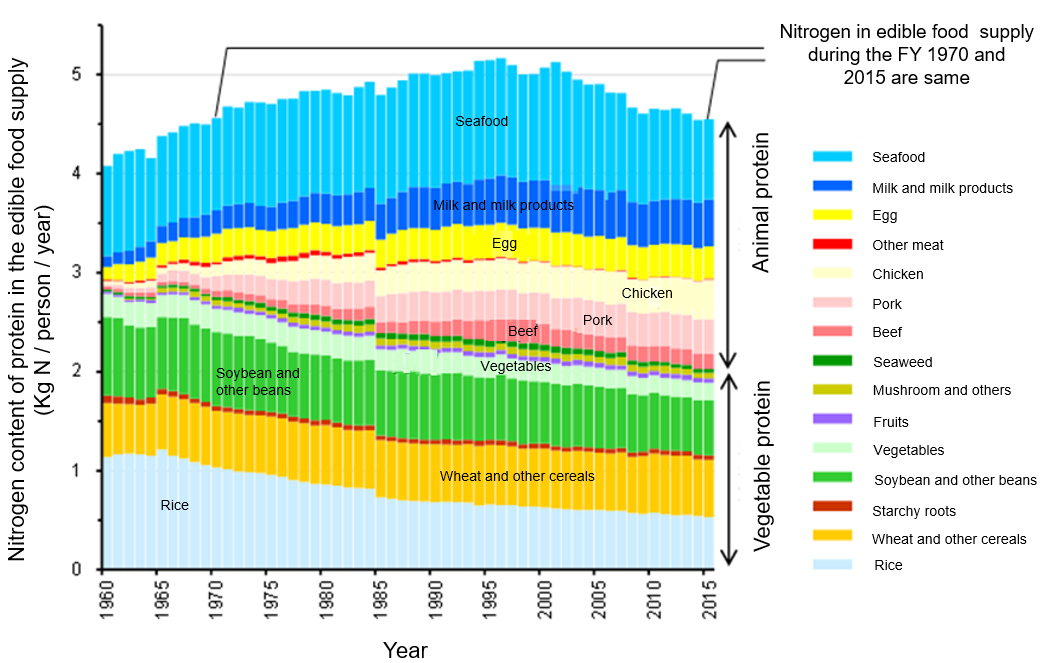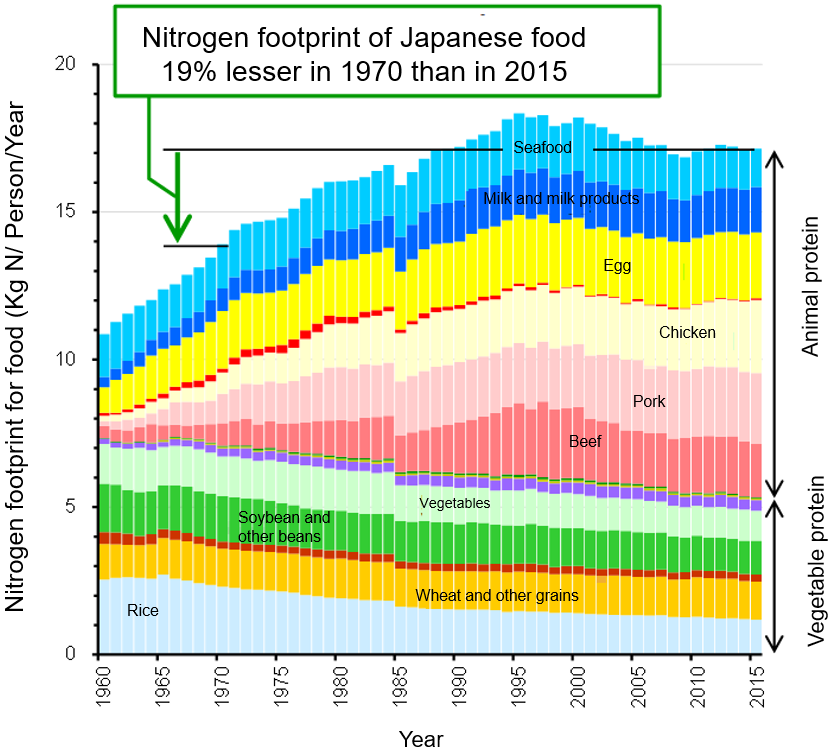NARO has revealed for the first time the long-term transition of the nitrogen load (= Food Nitrogen Footprint) generated in the domestic and overseas environment due to food consumption in Japan. Our diet (from which food protein is consumed, protein overconsumption, food loss, etc.) has a major impact on the nitrogen footprint for food. It was shown that the key for solving various global environmental problems caused by the nitrogen load lies in each individual's food consumption behavior.
Overview
The protein in our food contains 16% nitrogen (N). In the process of producing and consuming this "food nitrogen", a lot of nitrogen (reactive nitrogen) is discharged into the environment, which has various negative effects on the regional and the global environment (groundwater contamination by nitrate nitrogen, eutrophication of lakes and marshes, global warming and ozone depletion due to nitrous oxide etc.).
In this study, Nitrogen statistics related to Japanese dietary habits (changes in food preferences, excessive protein intake, food loss, etc.) calculated based on statistical data and long-term transition over the past half century of the nitrogen load (= Food nitrogen footprint) generated in the domestic and overseas environments during the process of food production and consumption are estimated for the first time.
It was revealed from the result that (1) Currently (FY 2015), 22% of "food nitrogen" supplied for domestic consumption is excessive protein consumption and 11% is food loss. (2) Food loss in Japan has become prominent since the latter half of the FY 1970s after excessive consumption of protein, which increased rapidly during the period of high economic growth, reached its maximum value, after doubling around the FY 2000, it is gradually decreasing in recent years, (3) Japanese food around the FY 1970 (beans and seafood proteins occupied larger part of total protein supply), where almost the same level of protein was supplied as compared with FY 2015, had a 19% lesser nitrogen footprint in the food.
This research result indicates that reducing food loss and living in accordance with Japanese dietary reference intake will be a key for solving global environmental problems. Through "food education", etc., it can be used as scientific information for each person to consider the cause of environmental problems caused by nitrogen load as familiar problems.
For Inquiries
Contact: http://www.naro.go.jp/english/inquiry/index.html
Reference Information

Fig. 1 Nitrogen flow and nitrogen footprint related to food
This is a schematic diagram of the nitrogen flow related to food as a stepped waterfall (cascade). There is a leak (discharge of nitrogen into the environment) from the nitrogen pool at each stage. "New" nitrogen (biologically available nitrogen compounds: reactive nitrogen) introduced into the farmland at the uppermost stream of the waterfall is used for crop production in the upstream, feed for livestock near the middle stream, and consumed by consumers as food at the downstream end. The total amount of nitrogen released into the environment during these processes is the nitrogen footprint.

Fig. 2 Long-term transition in nitrogen amount related to food supply and intake in Japan
(long-term transition of overconsumption of protein and food loss)
Currently (2015), 22% of the protein in domestic edible food supply is excessive and 11% is food loss. Reduction of excessive protein intake and food loss leads to the reduction in edible food supply and non-edible parts, as well as reduction in nitrogen input amount in the agriculture and livestock farming. Consequently, it is possible to reduce the total nitrogen footprint for food in the food chain system by a total of 33% (719 Gg N / year).
In this study, the Japanese Dietary Reference Intake recommended by the Ministry of Health, Labor and Welfare (previously 2004 "Japanese Recommended Dietary Allowance") is regarded as the optimal protein intake for Japanese consumers. The actual protein intake was obtained from the National Health and Nutrition Survey (Ministry of Health, Labor and Welfare), and the difference between the two was considered to be equivalent to excessive protein intake. Also, the difference between the protein from edible food supply for domestic consumption and the actual protein intake was considered food loss. In addition, the difference between the gross food supply and the edible food supply corresponds to the amount of nitrogen in the non-edible part, resulting in food waste.


Fig. 3 Long-term transition in nitrogen amount by major food groups included in the edible food supply per consumer in Japan (top) and estimated value of food nitrogen footprint (nitrogen load into the environment) associated with it (bottom)
In order to know the impact of long-term transition in food preferences on the nitrogen footprint for food, the nitrogen footprint of "Japanese food" are compared, mainly focusing on the FY 1970 and 2015 when the nitrogen amount of edible food supply is almost equal. It was found from the result that for the "Japanese food" in FY 1970 , the nitrogen footprint was 19% lesser. In this figure (bottom), in order to focus only on the impact of changes in food preferences on the nitrogen footprint for food, the calculation results are based on the assumption that the nitrogen use efficiency (= nitrogen use / nitrogen input) in the production process of past agricultural, livestock and fishery products is the same as the current (FY 2015).




